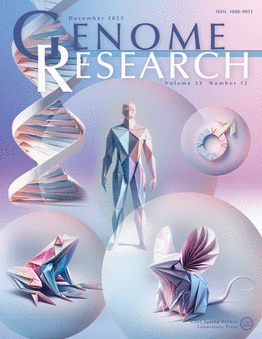两只具有 ZZ/ZW 和 XX/XY 性染色体的隐翅龟的全新基因组组装揭示了基因组重组模式,并发现了羊膜动物新的三维基因组折叠方式
IF 6.2
2区 生物学
Q1 BIOCHEMISTRY & MOLECULAR BIOLOGY
引用次数: 0
摘要
了解物种间染色质构象的进化是阐明基因组结构和可塑性的基础。线性距离较远的基因座之间的非随机相互作用以物种特有的模式调节基因功能,影响基因组功能、进化,并最终影响物种分化。然而,来自非模式生物的数据却很少。为了捕捉脊椎动物染色质构象的宏观进化多样性,我们在这里通过Illumina测序、染色体构象捕获和RNA-seq,为两只隐颈龟(Apalone spinifera (ZZ/ZW, 2n = 66)和Staurotypus triporcatus (XX/XY, 2n = 54)生成了全新的基因组组装。)除了在线性基因组中检测到的融合/分裂事件外,我们还检测到龟鳖的三维(3D)染色质结构与其他羊膜动物存在差异。也就是说,全基因组比较揭示了龟类染色体重排的不同趋势:(1) Apalone(龟鳖目)的基因组重排率较低,其核型与鸡相比高度保守(可能是龟类的祖先);(2) Staurotypus(龟鳖目)和 Trachemys scripta(龟鳖科)的融合/裂变率适中。此外,我们还发现了一种染色体折叠模式,这种模式可使 "中心粒-端粒相互作用 "成为可能,而这种相互作用以前在龟类中尚未发现。龟类的 "中心粒-telomere相互作用"(在此发现)加上 "中心粒聚类"(以前在猿猴类中报道过)的组合模式在羊膜动物中是新颖的,它反驳了以前关于羊膜动物三维染色质结构的假说。我们假设,在龟类中发现的分化模式起源于羊膜动物的祖先状态,这种祖先状态是由核构型确定的,核构型中的微染色体之间存在广泛的关联,这种关联在线性基因组重新洗牌后得以保留。本文章由计算机程序翻译,如有差异,请以英文原文为准。
De novo genome assemblies of two cryptodiran turtles with ZZ/ZW and XX/XY sex chromosomes provide insights into patterns of genome reshuffling and uncover novel 3D genome folding in amniotes
Understanding the evolution of chromatin conformation among species is fundamental to elucidate the architecture and plasticity of genomes. Nonrandom interactions of linearly distant loci regulate gene function in species-specific patterns, affecting genome function, evolution, and, ultimately, speciation. Yet, data from nonmodel organisms are scarce. To capture the macroevolutionary diversity of vertebrate chromatin conformation, here we generate de novo genome assemblies for two cryptodiran (hidden-neck) turtles via Illumina sequencing, chromosome conformation capture, and RNA-seq: Apalone spinifera (ZZ/ZW, 2n = 66) and Staurotypus triporcatus (XX/XY, 2n = 54). We detected differences in the three-dimensional (3D) chromatin structure in turtles compared to other amniotes beyond the fusion/fission events detected in the linear genomes. Namely, whole-genome comparisons revealed distinct trends of chromosome rearrangements in turtles: (1) a low rate of genome reshuffling in Apalone (Trionychidae) whose karyotype is highly conserved when compared to chicken (likely ancestral for turtles), and (2) a moderate rate of fusions/fissions in Staurotypus (Kinosternidae) and Trachemys scripta (Emydidae). Furthermore, we identified a chromosome folding pattern that enables “centromere–telomere interactions” previously undetected in turtles. The combined turtle pattern of “centromere–telomere interactions” (discovered here) plus “centromere clustering” (previously reported in sauropsids) is novel for amniotes and it counters previous hypotheses about amniote 3D chromatin structure. We hypothesize that the divergent pattern found in turtles originated from an amniote ancestral state defined by a nuclear configuration with extensive associations among microchromosomes that were preserved upon the reshuffling of the linear genome.
求助全文
通过发布文献求助,成功后即可免费获取论文全文。
去求助
来源期刊

Genome research
生物-生化与分子生物学
CiteScore
12.40
自引率
1.40%
发文量
140
审稿时长
6 months
期刊介绍:
Launched in 1995, Genome Research is an international, continuously published, peer-reviewed journal that focuses on research that provides novel insights into the genome biology of all organisms, including advances in genomic medicine.
Among the topics considered by the journal are genome structure and function, comparative genomics, molecular evolution, genome-scale quantitative and population genetics, proteomics, epigenomics, and systems biology. The journal also features exciting gene discoveries and reports of cutting-edge computational biology and high-throughput methodologies.
New data in these areas are published as research papers, or methods and resource reports that provide novel information on technologies or tools that will be of interest to a broad readership. Complete data sets are presented electronically on the journal''s web site where appropriate. The journal also provides Reviews, Perspectives, and Insight/Outlook articles, which present commentary on the latest advances published both here and elsewhere, placing such progress in its broader biological context.
 求助内容:
求助内容: 应助结果提醒方式:
应助结果提醒方式:


